#Sedimentation prevention.
Text
Water Tank Services
Tank Inspection: Regular inspections are crucial to identify any issues or damage in water tanks services . Professionals assess the tank's structural integrity, check for leaks, evaluate the condition of fittings and valves, and recommend necessary repairs or maintenance.Tank Cleaning: Water tanks accumulate sediment, debris, and microbial growth over time. Professional tank cleaning services involve the removal of sludge, disinfection, and sanitization to ensure the water remains safe and clean.
#Water tank cleaning#Tank maintenance#Tank sanitation#Sediment removal#Algae control#Bacterial growth prevention#Tank disinfection#Water quality improvement#Sludge removal#Tank inspection#Filtration system#Chlorination process#Waterborne diseases#Tank hygiene#Reservoir cleaning#Water purification#Scale buildup prevention#Tank flushing#Decontamination#Rust removal#Tank sterilization#Biofilm control#Tank renovation#Water storage maintenance#Sedimentation prevention.
1 note
·
View note
Text
Proposed logging project in the Daniel Boone National Forest (South-Central Kentucky, USA)
I found out about this recently and Ive seen barely any discussion or attention about it in real life or on the internet, so hopefully I can attract more attention
The USA Forest Service is planning to log 10,000 acres of the Daniel Boone National Forest near Jellico Mountain, near the Kentucky-Tennessee border. The plan includes around 1,000 acres of clear cutting.
We need mature forests to remove and store carbon from the atmosphere. This is disastrous from a climate change perspective.
The excuse being given (apart from the obvious economic incentive of logging) is that the tract is mostly "mature forest" and that the forest needs to have a "diversity of age classes" for wildlife. This is total bullshit, since less than 1% of old growth forest in the Eastern USA remains, and an 80-year-old forest is still incredibly young. This type of reasoning is greenwashing.
To make matters worse, the planned logging is on mountain tops, which will cause huge amounts of erosion and possible floods and landslides that endanger the people who live in the valleys below.
Kentucky experienced a deadly flash flood in the eastern mountains that killed 40 people last year. Forests help stop flash flooding by absorbing rainfall in a dense layer of roots and soil, draining it slowly into waterways; without them, mud and rainwater goes rushing straight into narrow mountain gullies rapidly, causing dangerous floods.
Mud and sediment rushing into streams also kills fish and aquatic life that need clear, clean stream water.
Kentucky has one of the most biodiverse freshwater ecosystems in the entire world, with only a couple states next to it having more freshwater species. Kentucky's forest streams have fresh water fish, crustaceans and other species found nowhere else on Earth.
The Southeastern USA has the most diverse freshwater life of any place on Earth, the most salamander diversity of any place on Earth, and the Appalachian Mountains are a global hotspot of biodiversity, considered one of the world's most biodiverse temperate deciduous forest habitats.
It is crucial that we begin building the old-growth forests of the future NOW!
Logging these forest tracts will facilitate invasive species to take over. Mature forests form buffer zones against invasive species. The forest will never grow back the way it was; it will be infected with Kudzu, Autumn Olive, Honeysuckle and other invasives that take advantage of the destruction and prevent the normal process of forest succession from happening as it should.
If you live anywhere near this area, talk to everyone around you about this, send them the links above and encourage them to do the same themselves.
Talk to your friends, your neighbors, people at your church, everyone you are in contact with or speak to in your day to day life. Tell them about the risks of flash flooding and landslides and the importance of preserving mature forest land. Any environmental clubs and organizations you know of, tell them as well.
Most people haven't even heard this is happening, and that's how they get away with it.
Public outrage protects priceless habitats all the time, so TELL EVERYONE YOU KNOW. Tell people you don't know, even. Call and email organizations and people that might be interested, until you run into someone who has an idea of what to do. That's how change happens!
1K notes
·
View notes
Text
Your mission is simple: provide fire support from a distance while your comrades engage the primary target. You've been specifically chosen for this job. You've always excelled in long-range engagements, and this is a perfect opportunity to stress test the prototype long-range cannon your sponsor has been developing. You don't know the name of it, you were just given the machine and told to make it work. A piece of cake for you, given your experience.
The cannon you were told to use is heavy. Heavier than anything your suit has ever carried before. There's a twinge of worry that the servos and joints might buckle under the weight, but you trust your machine to carry you and the payload to your destination. It always has.
You arrive at your sniper's nest and prepare the cannon for firing. This thing is massive. The barrel is long, and thick, made of high-quality alloys that even you can't quite recognise. The firing mechanism and bolt action nature of it is simple, yet powerful. Setting this up on the ground is like assembling a mortar. Multiple pieces, big and small, but all forming to make something so much bigger than the sum of it's parts.
You revel in the sounds and feel of the assembly - the clicking and snapping of smaller parts, the sound of friction when metal slides on metal, the delicate nature of it all. There's no way a pilot can do this on their own without their mech, the machinery is simply too large and complex. You work alongside your suit, controlling it as the optical scanner guides your vision and thought process. It is the mind, and you are the hands.
Within minutes, you are finished the assembly. Faster than anyone else could have ever hoped to do it. There's a while longer before the mission is set to start, so you take some time to appreciate this machine of war. Trace the fingers of your mech's hands along it, and feel the grooves and imperfections through the haptic feedback of your controls. Inspect the bolt, the cartridge that holds your ammunition, the scope, everything. Everything about this is perfect to you. It's like this was made specifically for you to use. It's beautiful. It's love, and it's hurt, and it's yours.
It's almost time.
You lay the cannon on the ground, with the tripod attacked to the barrel sticking into the dirt. You use the mech as an extension of yourself in order to position yourself comfortably. Your legs fall to each side of the cannon as you lay above it, almost as if you intend to mount it. Your feet dig into the ground, preparing yourself for the inevitable recoil that firing this artillery will bring. Your knees fall to the ground, for further stability, and your body is mere inches away from touching the hardened steel of this machine below you. Your dominant hand reaches for the trigger, and your free hand holds the top of the barrel down to prevent it from flying away when you fire. You position your head perfectly in line with the scope, and you can see your allies now engaging with the target. You are ready to fire.
Your breath is shaky, heavy and getting faster. This is... exciting. You can't wait to pull the trigger and see how much damage this cannon will do. You're already thinking of names to give it, of how to modify it to make it more reliable, of how to make it yours. All yours. Your eyes are trained on the target, and you're listening to the comms channel for your order to fire, though your focus only allows you to parse half of what is being said.
Finally, you hear the order. Through half-understood chatter, you hear a loud and stern "fire". You pull the trigger.
Time slows.
First, you feel the recoil of the firing mechanism pushing back against you.
Then, the deafening, piercing sound of the combustion that propels the bullet forwards towards your target.
The cannon pushes back against you and pushes you both back several feet, leaving a trail of dug-up dirt and sediment around where you and your weapon are planted. You feel the joints of your suit scream against the strain of the sheer force, and the haptic feedback from your controls is going haywire.
Everything hurts. This hurts to use.
But it's worth it. You feel amazing. You feel alive.
A sudden gasp leaves your mouth, and you start breathing heavily. The ringing in your ears, the tingling feeling in your hands, the pain you feel must be the same way your suit feels in this moment. You are as one. You are together.
But there's no time to revel in this feeling. You have a mission to complete. Another round needs to be prepared before your comrades are struck down. This is what you're ultimately here for.
You don't even have a chance to look at the damage this cannon dealt, you simply start reaching for the next cartridge to load.
You pull back the bolt on the cannon, feeling the friction of it sliding against the body of this gargantuan weapon.
The used cartridge falls to the ground, cracked from the force of this machine, with wisps of smoke trailing off of it.
You hastily slide the fresh cartridge in, holding it in place with one hand as you push the bolt forward to lock it in place.
The strained joints of your suit ache and tremble as you use all of your strength to push, and eventually you load the next shot.
The barrel is still red hot, and dangerous to the touch, but you have no choice but to stabilise it like you did before. There's no time to worry if the heat will melt you suit's hand onto this thing. A small part of you wouldn't even mind if it did.
You readjust your sights and focus on the target again, and finally, you can admire the damage that this cannon did. It's a miracle that your shot didn't finish the job, but that's okay. You have plenty more.
This next one should do it.
Once again, your focus is trained on the comms channel, waiting for the firing order.
Breath getting faster, heavier, warmer. Heart beating out of your chest. Feeling pistons, servos, joints, every mechanism of your suit as a part of you.
"Fire"
168 notes
·
View notes
Text
This Wet Beast Wednesday I'm going to talk about gars. This needs some clarification because there are a lot of different fish called gar, garfish, or garpike. I'm referring to fish of the family Lepisostidae, the only surviving members of the ancient clade Ginglimodi, which I mostly brought up because Ginglimodi is a funny name.
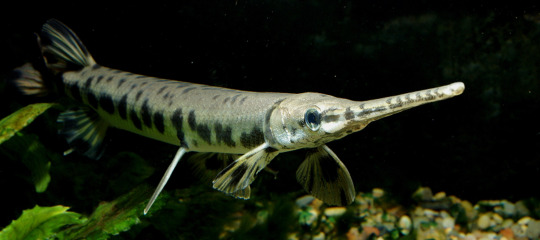
(image: a longnose gar)
Gars are predatory fish found exclusively in North and Central America, though they have been introduced outside of their native range. Their ancestors evolved in Triassic period and once occupied most of North America and large portions of Europe back when the continents were still connected. They are freshwater fish, though a few species will go into brackish or even marine waters temporarily. The name "gar" is though to come from the old english word for "spear", which is appropriate as gar are very elongated fish and often have pointy snouts. Many other groups of elongated fish are also given the common name of gar or garfish for this reason. Their long snouts are filled with sharp teeth which are used to crush through shells and flesh. Gars are opportunistic predators who feed largely on crustaceans, frogs, and fish and will eat carrion if they find it. The long snouts are also used to dig through sediment in search of prey They move slowly through the water, but are capable of short bursts of speed to catch prey. Most species are apex predators with no natural predators as adults.
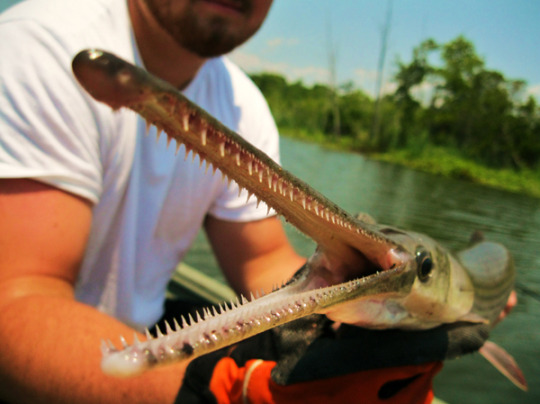
(image: a longnose gar with mouth open, displaying the teeth)
The body of a gar is covered with thick, diamond-shaped scales. Their scales are an ancient variety known as ganoid scales which are notable for their shape and composition. Where most bony fish scales have layers of a spongy, bony substance called cosmene, ganoid scales instead have an enamel-like substance called dentine, which is also a component in teeth. The scales are also covered in a rigid, glassy substance called ganoine where other scales use enameloid. Ganoid scales also don't overlap, instead laying next to each other in a manner that provided protection while still allowing flexibility. The result is a suit of armor that makes gar very durable. Because of how durable the scales are, they habe been used by humans for many purposes. Multiple Native American groups would use scales as arrowheads, there are reports of native Caribbean peoples wearing breastplates made of gar skin, and Europeans colonists would layer their plow heads with the scales to protect the,. There is currently a market for jewelry made of the scales.
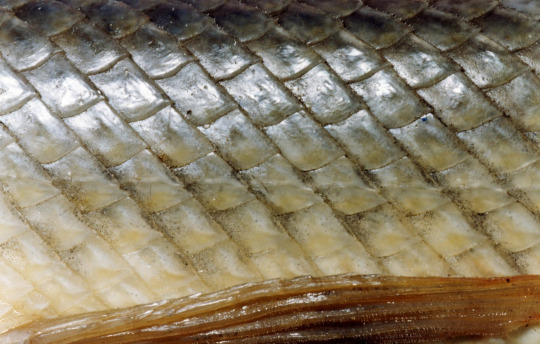
(image: a close-up of ganoid scales)

(image: an arrowhead made of a gar scale)
Gar typically lay their eggs in early spring, with the female coating vegetation with thousands of sticky eggs. The eggs are toxic to humans, capable of causing sickness when ingested. Because of this, they are unsuitable for caviar. Scientists initially thought that the toxin was an adaptation to prevent predation, but natural predators of the eggs like channel catfish and bluegill are immune. Crayfish are affected by the eggs, though it's not clear if the poison is an adaptation targeting them or not.

(image: a shortnose gar)
The swim bladder of gar is highly vascularized, allowing them to act as lungs. Most gar will surface occasionally to take a gulp of air. While they are capable of surviving on their gills alone in good-quality water, air gulping allows gar to thrive in low-oxygen water where their prey will be sluggish from oxygen deprivation. Most species live around 20 years, but the alligator gar can live upwards of 70 years.
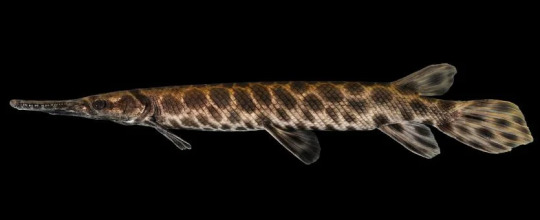
(image: a spotted gar)
There are seven living species of Gar: the Cuban gar, tropical gar, spotted gar, longnose gar, shortnose gar, Florida gar, and alligator gar. The shortenose gar is the smalles species, reaching an average length of 62.5 cm (24.6 in) while the alligator gar is the largest species and one of the largest of all American freshwater fish at an average length of 1.8 m (6 ft) in length. The largest alligator gar on record measured in 2.57 m (8 ft 5 in) and 148 kg (327 lbs). Alligator gar were long considered a nuisance species by fishermen as they preyed on sportfish and as a result, they were frequently killed. This resulted in population losses and the fish being extirpated from many states it was once native to. Now multiple states have laws and regulations protecting them and the population is starting to see a resurgence. Alligator gar and now a popular sportfish and have been introduced to places outside of their native range, becoming an invasive species in many areas including China.

(image: two fishermen with an alligator gar)
Gar meat is edible and is described as having a very unique taste compared to other fish meat. They are not commonly eaten in modern times, but some people consider them a delicacy. Gar meat is known to carry environmental toxins like pollutants and heavy metals, which can make eating them risky. Gar are mostly fished for their scales or for sport. Only the Cuban car is endangered (and critically so) while other species may be locally endangered, but as a whole are not threatened. Gar are used as aquarium fish due to their unique appearance, though they need large tanks due to their size.
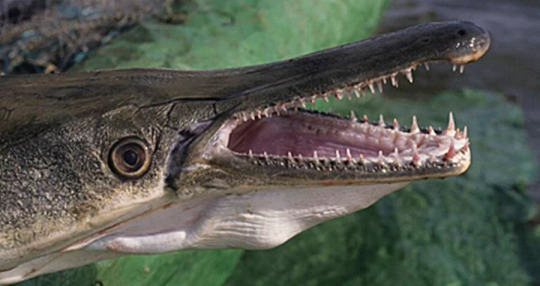
(image: a close-up of an alligator gar's head)
#wet beast wednesday#aquatic biology#fishblr#fish#ecology#zoology#animal facts#gar#longnose gar#shortnose gar#alligator gar
538 notes
·
View notes
Text
someone asked for a lore dump of my sea monster au in its current state, so here’s a dump from my alt retrospring a few days ago:
TW: injury, blood mention
Frye (human) lives on a nearby bay and is a fisher with a cute lil boat. One day she gets a tip about some sunken treasure and goes out with the intention and promise of paying off a debt. She takes the map she's given and goes out under the cover of night. It's a long search, but she eventually finds the point marked on the map and lowers a hook to see what she can dislodge. She hooks up something pretty damn heavy and connects the dots and assumes it to be the treasure, but on the way up it seems to snag on something. She tries to wiggle it free of whatever kelp it's caught in, but then it starts getting pulled down. She guesses it's probably just a sea creature and, getting desperate, takes out her harpoon and makes a shot in the dark before the treasure can be pulled away any further. And the water stains darker.
Surprise surprise, she's able to pull up the crate but an injured Shiver comes with it and she's initially alarmed that she shot a diver, but when she hauls them into her lap she realises from scale and tendril that they're decidedly not human. She hit them square in the eye - they're still breathing but are barely conscious when she hauls them up. She looks into the crate and sees that it's weighed down by rock and sediment, not gold or silver. She'd been scammed. She's gonna return empty-handed, unless... she barely considers it for a second before she looks down at the sea monster weakly gazing up at her with one less eye. And she makes a decision. She covers their eyes to try and prevent them from struggling and making the damage worse but it just makes them panic more. "Hold- still- you're gonna hurt yourself more-" and just wedges the handle of an oar between their jaws for them to bite down on assuming it's her arm. The wood cracks beneath their teeth.
Frye does her best with what medical supplies she has to patch them up and remove the spear from their face, and when she uncovers their eyes and pulls away the oar they shove her away and go to dive off before realising they probably won't be able to make their way back home with their limited eyesight. So it's just this silent temporary truce, they don't say a word to her as they guide where to steer and eventually make her halt. Glances at her once, and dives away, supposedly never to be seen again. Frye just feels guilt and- faint longing. It's a fascinating encounter. And it leaves both of them curious.

The next day, she goes out fishing in the noon (having slept in from her late night antics) and something tugs on her line and startles her awake. She goes to reel it in, but a hand comes with it. A familiar, clawed one. She watches the scarred face peek up from the waters, studious gaze barging into her. And they pat the boat. And she lifts them on board, remarking how heavy they are. They snap that they're not, and conversation quickly spirals out, initially panicked and confused, but then. Softening as Shiver asks more and more questions, trying to understand her intentions. She profusely apologises, and they're fascinated by her and become a regular appearance for her.

That's me trying to break it down anyway. They're really cute. Frye has that "shot them in the face with a harpoon" rizz.
#tw blood#splatoon#sea monster au#shiver splatoon#shiver hohojiro#shiver#frye splatoon#frye onaga#frye#shivrye#shiver x frye#fryever
126 notes
·
View notes
Text
The Cape Fear Shiner, a golden boi

The Cape Fear Shiner, Notropis mekistocholas, is a small endangered species of minnow only found in the Cape Fear River Basin in North Carolina. It's protected under the Endangered Species Act and is extremely hard to find, currently only being found in two rivers and a few tributaries.

Cape Fear River, North Carolina. Their range fell with the construction of dams across the Cape Fear river basin, preventing the fish from reaching their critical habitat and other populations of their species, decreasing genetic diversity. Dams also change the movement of water, and still water is not ideal for this fish, nor is the abundance of its invasive predator, the flathead catfish.

Flathead Catfish, Pylodictis olivaris. The shiner is very susceptible to changes in water quality, which have also decreased their populations. Things like increased sedimentation, the dumping of wastewater into local waterways, and runoff from cities and agriculture all hurt this fish and prevent them from thriving. The overflow of manure lagoons from hog farming are especially a problem that affect the waterways. The disappearance of this fish shows how the water quality of North Carolina is declining.

Manure lagoon, North Carolina. However, there are efforts to keep this fish from disappearing. There have been dam removals to allow fish to reunite, captive breeding to increase their numbers without relying on the small wild populations, fishers targetting invasive fish like the flathead catfish, and general efforts to improve water quality across North Carolina with improved regulations. There is hope for this fish to recover and return to its previous abundance.

Many Cape Fear Shiners, Notropis mekistocholas.
45 notes
·
View notes
Text
Fossil Novembirb 10: Bayou in the Badlands

Fluvioviridavis by @quetzalpali-art
Back to Eocene Ecosystems! One of the most famous Eocene fossil sites in the world is the Fossil Lake site of the Green River Formation, an ecosystem from Colorado in the United States. This ecosystem records the transition from the moist forested world of the early Eocene to the drier warm world of the mid-Eocene. The forests would begin to shrink back, the foliage would change, and so would the animals.
Fossil Lake records the start of that process! Sediment would regularly settle into this lake at periodic intervals, which then recorded the evolution of the lifeforms there over thousands of years. The forests were filled with sycamore trees and other broadleaf plants, as well as ferns.

Limnofregata by @iguanodont
Because the lake was so frequently filled with sediment, oxygen levels were low to nonexistent, preventing decomposers from living at the bottom of the lake. This lead to many different organisms being preserved nearly perfectly, including many gorgeous birds!
In fact, the Field Museum of Chicago - my home - has many of these wonderful fossils on display, and have fascinated me since childhood. So I'm going to break format a little here to showcase some of these fossils.

Cyrilavis, a Halcyornithid (Parrot-Passerine of Prey)
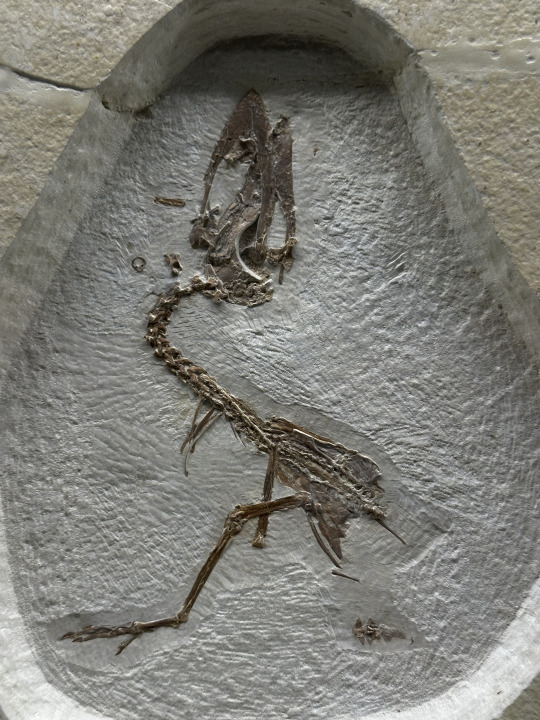
Fluvioviridavis, a Strisorian (like oilbirds or frogmouths)

Eofringillirostrum, a Passerine

Limnofregata, a Frigatebird in a Gull Niche

Nahmavis, a relative of shorebirds (Charadriiformes) or rails and cranes (Gruiformes)
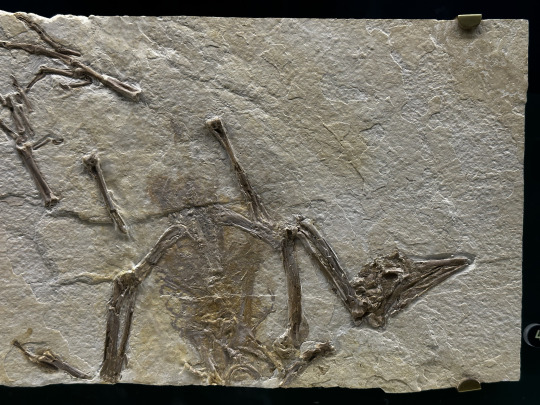
An unnamed Anseriform, probably similar to Anachronornis

Celericolius, a mousebird

Zygodactylus, a stem-passerine
We see once again in this ecosystem - as we have in the others we've covered - the common theme of Avian evolution: the niches may stay the same, but the birds filling them will always change. We have Mousebirds perching in trees in North America, we have Frigatebirds filling the Gull niche, ducks wading around the lake like flamingos, and cousins of parrots/passerines hunting prey.

Presbyornis by @drawingwithdinosaurs
Other notable dinosaurs from this formation include Presbyornis, another one of those Flamingo-Ducks we've talked about like Teviornis and Conflicto; Gastornis because it was literally everywhere from the latest Paleocene through the early Eocene; Lithornithids like Pseudocrypturus because they were also everywhere; early landfowl like Gallinuloides; the cuckoo-roller Plesiocathartes; the ibis Vadaravis; and the turaco relative Foro. Once again, we see many tropical birds in places where they aren't today, due to the extensive warm climate of the Early Eocene.

Foro by @drawingwithdinosaurs
This swampy ecosystem was filled with large crocodile relatives, small mammals, the earliest known bats, giant lizards, and an alarming number of fish - making it one of the better known ecosystems of the early Paleogene. But the best known Paleogene fossil location is still to come...
Sources:
Grande, L. 2013. The Lost World of Fossil Lake: Snapshots from Deep Time. University of Chicago Press.
Mayr, 2022. Paleogene Fossil Birds, 2nd Edition. Springer Cham.
Mayr, 2017. Avian Evolution: The Fossil Record of Birds and its Paleobiological Significance (TOPA Topics in Paleobiology). Wiley Blackwell.
79 notes
·
View notes
Text
You need a mountain to make a sword
Mt. Youkou, which only exists in the Kimetsu no Yaiba universe is essentially named "Mt. Sunlight," is said to receive the most sunlight, which gets soaked into the Shoujouhi iron ore and Shoujouhi iron sand—both of which also only exist in this universe and are named for a particular shade of red. This mountain is therefore crucial to the development of Nichirin blades, and deserves more focus than a one-time mention in Chapter 9. If demons were to find this place and prevent them from mining, the Corp would be screwed.

A mountain is a finite resource, though. This post was supposed to be short and simple to say:
1. Large portions of that mountain are lost in the effort to collect the sunlight-soaked iron sand
2. Large portions of that iron sand is lost in smelting it into steel
3. Large portions of that steel is lost in the smithing process
But of course, it is not short and simple, I have more to say about charcoal and what this all means within the context of the KnY world and additional speculation about the production of Nichirin blades.
First you need to break the mountain!
Okay, so you start with a mountain. This one is said to be “closest to the sun,” which has made some people theorize that this is the tallest mountain, Mt. Fuji, but perhaps that is just a way of saying it is in a sunny spot in the east. The main criteria is that it is very exposed to the sun. I think the "it doesn't rain" there thing is an exaggeration, as there are trees drawn there, so I assume it has some sort of a water source.
I will focus primarily on collecting the Shoujouhi iron sand as opposed to the ore, because in real life steel smelting in Japan, iron sand was more widely available than ore—and however they got the Shoujouhi ore, I’m guessing it was more of a process of scraping it off exposed parts of the mountain instead of digging deep in the dark for it. It used to be that that iron sand was collected in rivers and lakes from the natural, slow erosion process, but going by the illustration in the manga panel, they appear to practice kanna-nagashi, a process of collecting iron sand in large amounts by speeding up the natural erosion process by scraping off chunks of granite mountain into man-man waterways, and channeling it through a series of collection pools to sort the heavier iron sand from the rest of the sediment. Another reason to suspect this method is because the "Kana" of Kanamori's name is written with the same "kanna" kanji: 鉄穴 ("iron cavity," as opposed to the more common real life last name Kanamori which uses the simple 金 for metal/gold).

In the heyday of real-life traditional iron and steel smelting with iron sand, kanna-nagashi resulted in mountains being leveled because they used up so much of the natural environment. This was used for meeting almost all of the iron and steel needs of populous Edo period society, which did not need as many swords as in previous eras but needed anything from tools and nails to pots and pans. The swordsmiths in Kimetsu no Yaiba only needed to make swords for the Demon Slayer Corp (which we’ll use for referring to the organization’s full history, though it was less formally called “the demon hunters” for most of its existence). The swordsmiths making Nichirin blades were probably frugal with the precious Shoujouhi iron. They needed to make it last for as many centuries as it would take to defeat Kibutsuji Muzan.
Not all iron sand is created equal!
While what's very crucial to Nichirin blades is that the iron that has soaked up the power of the sun, what's also crucial to making Japanese blades is a high level of purity in the iron. To put this in perspective, the more common kind of real-life iron sand (akome) that could be used for general iron needs might make up 5-10% of the rock plucked off the mountain, but masa iron sand, the kind that was (and still is) preferred for making Japanese swords might only make up about 0.5-2%. These sands would differ in size, the amount and array of impurities, and how high of a temperature and how long you need to smelt them. However, the real-world smelting process for making sword-quality steel used a mix of these two kinds of iron sands, so it might be reasonable to assume they stretch out the Shoujouhi iron sand supply by supplementing it with high quality sands from other nearby, shadier mountains. There is also the matter of how much of it was Shoujouhi ore, and how much of that ore was available relative to the sand on this fictional mountain, but I’ll focus primarily on a real-world iron sand based processes for consideration on numbers.
Anyway, we've perhaps already wasted at least 85% of what we've taken from the mountain to get this sand, and then it's time for smelting the Shoujouhi iron sand (and Shoujouhi iron ore, in this case) in a traditional tatara clay furnace, because for most of Japanese smelting history, that was what you had.
Tatara iron and steelmaking made the most of what Japan had!
Smelting iron in clay furnaces did not originate in Japan, but while many other places in the world had more abundant sources of iron ore to start with, Japan did not, so the tatara method was continually development to make the most of what was available: iron sand. Two of the other major ingredients in this method were clay and charcoal, the qualities of which were important in setting off the chemical processes of smelting the iron sand into pig iron (which would be refined into better iron or for steel for making swords). With Edo period developments in this Japanese smelting method, they were able to skip the pig iron step and achieve a sword-quality steel, tamahagane. Tatara is still the only method with which you can achieve tamahagane.
Look at this beautiful sword baby:

(Fun fact: Tamahagane is covered with many different colors—but rather than being indicative of Nichirin-like properties, these are tiny films of remaining impurities in the metal, which reflect light similar to how it bounces off a soap bubble or a CD. Cool, huh? I also tend to theorize that the coloring changing aspect of Nichirin is a matter of bending the visible spectrum of the sunlight contained within them.)
We don't have time here to go into the fascinating details about how this smelting process works and why tamagahane gives you the characteristic attributes of Japanese blades, but suffice to say, what's crucial is that tamahagane has a high level of purity and an ideal amount of carbon for making blades that are both strong and ductile. However, prior to the Edo period development of tamahagane, we don't actually know all the details about the materials used. Swords could vary widely in quality in the Sengoku period, and it's very likely that the high-quality ones (like what the demon hunters would had used) mixed stronger, imported iron with the local iron sand. This is another reason I'm willing to bet Nichirin blades might be reenforced with other material, though it is still entirely possible in-universe that they are purely Shoujouhi and the craftsmanship of the swords back then was purely thanks to the swordsmiths’ efforts.

A quick note here before we go on: historically, it makes the most sense for Tanjirou to have been offered tamagahane at the end of the Final Selection, because this was the standard material for Japanese swords at the time. In Chapter 8, Kiriya does not say “tamahagane,” but just “hagane,” which means “steel.” However, the first fanbook says that they choose their “kouseki,” which is “ore,” implying that this is still in a raw material stage. It’s possible that before the Edo period development of tamahagane, swordsmen were offered their choice of lumps of Shoujouhi ore, but given the speed with which Tanjirou received a completed sword, I’m willing to bet it had already undergone the smelting process with Shoujouhi iron sand in one big smelting batch. Although industrialized methods of smelting steel with mined iron ore, coke, and brick furnaces were already the norm by the early Taisho period, tatara was still in use, and still the only method of making tamahagane, so I am inclined to think the Swordsmith Village stuck with this and used tamahagane (and Japanese fans who are familiar with the tatara process all tend to assume the same, though most of the ones I've talked to about it are biased tatara nerds in the first place).
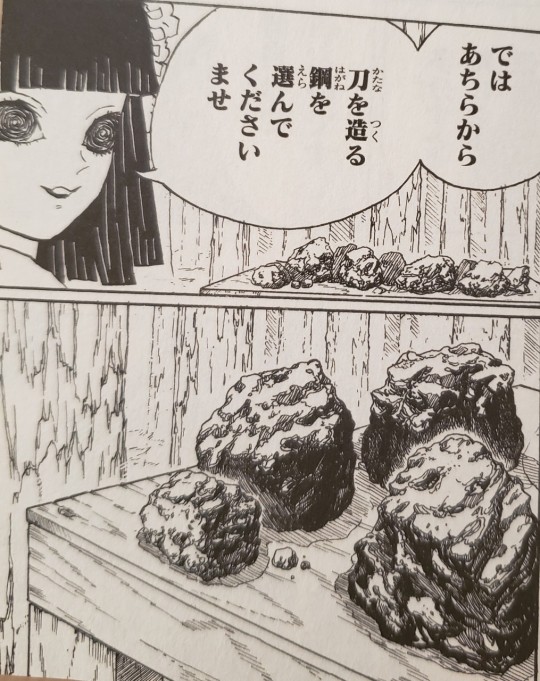
Charcoal is crucial in tatara and Japanese swordsmithing!
We also don't have time to go into detail about the clay or construction of the tatara furnace, but because this is KnY and I love charcoal, we will touch on that briefly: The charcoal used in tatara would be slightly different from the charcoal Tanjirou produced for household use or the charcoal used in multiple steps of the actual smithing process (both as a heat source and as a coating in a crucial step of the process). In a tatara furnance, it needed to burn quickly and at high enough temperatures to melt iron sand, it was left somewhat "undercooked" in the charcoal making process so as to leave more volatile organic components. Even with those sorts of adjustments to the charcoal making process specifically for tatara, Tanjirou could absolutely talk shop with the Swordsmith Village charcoal producers.
Also, in order to get trees big enough for tatara charcoal use, the trees were ideally 30-50 years old. Forestry methods in tatara charcoal production typically allowed the forest to grow back every 30 years, but this meant they needed roughly 30 different areas to cycle through and cut down from year to year. A single operation of the tatara furnace typically requires about 12 tons of charcoal, that is, roughly one hectare of forest. (This is why industrial tatara in real life usually required owning entire mountains in order to have that much forest available.)
What is one tatara operation?
For our purposes here, suffice to say that a tatara operation for the purposes of making tamahagane is a roughly 70-hour process of adding iron sand and charcoal to the flames every 30 minutes or so, resulting in a 2-3 ton lump of mixed metal, called a kera (which is written with sort of vivid kanji that makes it's like the "mother of metal," 鉧). What adjustments that might require to include Shoujouhi iron ore, I am not sure. It is an extremely labor-intensive process, with a high level of know-how required to be successful. It is very easy for the process to be ruined if the giant flames are not maintained, or the proportion of the materials is off, or if there is too much moisture or not enough constant air flow, etc. It also uses a lot of material. In addition to about 12 tons of charcoal, one operation typically requires about 10 tons of iron sand. Roughly 70% of the resulting kera would be tamahagane. That means, very roughly, that of the 10 tons of iron sand, only 15-20% remains as ideal sword material, but maybe only about 0.3-4% of the overall iron sand turns into top quality tamahagane.
How many swords are we talking?
The Swordsmith Village exclusively made swords for the Corp, which in Tanjirou's day and age is said to be “a few hundred” people (Chapter 4, and given the context, I assume this means “a few hundred swordsmen” as opposed to including outside supporting roles). Tamagahane for a katana is about 4 kilograms, so you can get, conservatively (and this is only my guess based on weight calculations, not on actually numbers of lumps of tamahagane I found results for), about 375 swords worth from one kera, or maybe up to 90 especially high-quality swords. We see anyone from a Mizunoto like Inosuke to a Pillar like Muichirou getting their swords replaced without much fuss, and clearly some styles of Nichirin blades require more or less steel (looking at you, Stone Pillar). The swordsmiths likely also use material for practice and trying new techniques, as well as for having extra swords available like those stocked up in the village.
I'll allow you to think backwards about how much mountain this consumes every year in a Corp that has been collecting ore and sand from Mt. Youkou for 800-1000 years, with the more damaging kanna-nagashi process being used for about 250-300 years. Instead, I will work forward to say that for a typical katana, that 4-kilogram tamahagane results in only a 1-kilogram sword, so you lose material at this stage too.
To recap:
The amount of Mt. Youkou destroyed but which gets collected as iron sand is only about 0.5-15% (if we're being generous). The amount of that iron sand which gets converted into tamahagane is only about 15-20% (or less if they are very stringent about Nichirin quality), though the numbers might be very different depending on the amount of iron ore used. The amount of tamahagane which remains as a finished sword is only about 25%. This is not even taking into account the amount of forest, clay, or even the series of stones necessary for the polishing process, not at all to mention expertise and labor.
So quit breaking your swords, Tanjirou.
Sources:
In modern day, the Society for the Preservation of Japanese Art Swords (NBTHK, or Nittouho) operates the Nittouho Tatara furnace three times every winter, so most of these numbers are based on their modern-day operations (though they do not practice kanna-nagashi, which was primarily practiced in the Edo period when tatara was a major industry). Other info primarily comes from other tatara related museums, especially the Okuizumo Tatara and Sword Museum and Wakou Museum, though it’s been glossed over for fandom purposes. Also, I’m a sword nerd anyway.
#SWORDS SWORDS SWORDS#KnY nerdery#KnY Reference#KnY References#I made it AS SHORT AS THE SPIRIT OF HAGANEZUKA WOULD LET ME
64 notes
·
View notes
Text

Strange Symmetries #09: Not Toeday, Satan
The shells of bivalve molluscs are formed on the left and rights sides of their bodies, and so are usually roughly bilaterally symmetric.
But some bivalves break that arrangement, developing asymmetrical valves that can be massively different in size and shape.
Gryphaea arcuata was an oyster that lived during the Early Jurassic, about 200-174 million years ago, in the warm shallow seas that covered what is now Europe and eastern Greenland. Around 6cm long (~2.4"), its left valve was thick and strongly convex and curled, while the right valve was relatively thin and slightly concave forming a "lid".
The gnarled curled claw-like shape of Gryphaea fossils led to them being colloquially known as "devil's toenails" in some of the regions where they're commonly found, with folk beliefs that they had the power to prevent joint pain.
Their shape was actually an adaptation to living on very soft seafloor sediments. The larger curled valve acted sort of like a boat on the soupy mud, supporting the Gryphaea's weight and preventing it from sinking.
———
NixIllustration.com | Tumblr | Twitter | Patreon
#science illustration#strange symmetries#paleontology#paleoart#palaeoblr#gryphaea#gryphaeidae#ostreida#oyster#bivalve#mollusc#invertebrate#art#devil's toenails
237 notes
·
View notes
Photo

Lake Ohrid and Lake Prespa, two of Europe’s oldest lakes, lie in mountains along the borders of North Macedonia, Albania, and Greece. The lakes have persisted for at least 1 million years, possibly longer. Ohrid has a mean depth of 155m to Prespa's 14m.
The Operational Land Imager-2 (OLI-2) on Landsat 9 captured this natural-color image of the lakes on August 19, 2022. Ohrid is the larger and deeper of the two, with a mean depth of 155 meters (509 feet). Prespa has a mean depth of 14 meters (45 feet).
The lakes owe their longevity to sustained tectonic activity that causes the land beneath them to sink, creating grabens, or low-lying valleys flanked by faults. This ongoing sinking of the valleys prevents sediment and plant life from building up and turning the lakes into bogs over time, as happens to most lakes after a few thousand years.
Most of the world’s millions of lakes are less than 18,000 years old and were formed when glaciers melted at the end of the last Ice Age. Geologists classify just 30 lakes, including Ohrid and Prespa, as “ancient”—defined by some researchers as persisting more than one ice age cycle (at least 130,000 years). Geologists think about 20 lakes on Earth, mostly found in grabens, have persisted for more than 1 million years.
Most of Ohrid’s water comes from underwater springs, but about 20 percent of it drains down from the higher-elevation Prespa through underground karst channels. While water levels have remained relatively stable on Lake Ohrid in recent decades, Prespa has experienced significant declines in both area and volume. In one recent study, based on nearly four decades of Landsat observations, scientists reported that Lake Prespa lost 7 percent of its surface area and half of its volume between 1984 and 2020, likely because of increased water withdrawals for agriculture.
The low-nutrient, high-oxygen waters of Lake Ohrid support more than 1,200 species of plants and animals, giving the lake one of the highest concentrations of biodiversity in the world. The longevity of Lake Ohrid has allowed for the evolution of 200 species that are found nowhere else, including unusual snails, ducks, and trout. The lake is a UNESCO world heritage site, and it is sometimes called the European Galapagos or a museum of living fossils due to its remarkable biodiversity.
The lakes aren’t the only local features notable for their ages. Ohrid, the largest town on the lake, is one of the oldest human settlements in Europe. It has the oldest Slav monastery and more than 800 Byzantine-style icons created between the 11th and 14th century.
328 notes
·
View notes
Note
8. rules
prompt from this list paired with a character suggestion from @druidx - this one features Baurus.
--
Baurus, at times, misses the Imperial City. The bustle of it, mostly, the swirling motion of commerce, the cacophony of the bells and half-a-hundred languages tossed around like cargo at the waterfront, and sometimes even the smell. He expected the hermetic rhythms of life in Cloud Ruler to chafe at him; braced himself for it on the trek north.
He could not predict the extent to which he took the amenities of city life for granted. Namely, the abundance of healers. Cheerful apothecaries with their tailor-made remedies, gentle hands at the temple coaxing wounds to seal.
For such things now they must rely on the Hero of Kvatch. Martin Septim, former priest, is a healer, but he has too important a role to play to be bothered with such trifles. Tanis Irathi is competent, but he is also a tyrant. A fortnight ago, the Grandmaster assembled them all to review reports on the Mythic Dawn’s movements. Baurus might have coughed a few times as Jauffre spoke, only to dislodge an itch in his throat. Afterward, Irathi — pacing the barracks like a captain dressing down his crew on the foredeck — forbade the Blades from catching disease.
He foists upon them bitter preventative tonics and sneers when they grimace at the taste. He sees someone sucking a cut and demands they sit for a healing, all the while relaying tales of rotten battlefield wounds that make even stalwart Captain Steffan go green around the gills. He nudges aside whoever’s on cooking duty to upend a mortar full of foul-tasting roots into a perfectly good soup, to make it more “fortifying.”
Irathi takes a scorched-earth approach with any malady. Baurus must admit it’s effective, and not entirely irrational. The Hero and his apprentice are the only residents of the temple with true freedom of movement — they cannot afford to fall ill, even for a short time. Baurus, too, would like to think that any miasma creeping up the barren mountain slopes would quail before his stern resolve.
—
Baurus is on cooking duty, crisping up fat little brook trout for breakfast. This is not the White-Gold Tower, there are no cooks or scullions here.
The heir pads in and mumbles out a greeting. He looks drawn, the pouches under his eyes darker than usual. He ladles up some tea from the pot boiling over the fire. Muffles a wet racking cough in his sleeve. Spills half the tea in his convulsion, curses. “Please, your Grace, let me.” Martin ignores him, mops up the mess, shuffles out.
He feels like a tattle-tale, but one look at Jauffre’s face tells him that the Grandmaster shares his concern. This cough could be the first sign of ruin to come, like the untimely reddening of the skies before an Oblivion gate bursts up from the soil. The end of the world precipitated by a cold. They are not healers, and thus find it easy to spin every little sneeze into a deadly portent.
And worse, Irathi and Coradri are due back in a week’s time. If he returns to discover the Blades keeping watch over a bedridden man, they will never hear the end of it.
Jena helps him locate Irathi’s cache of elixirs, jumbled at the bottom of a kitchen cupboard. “They’re not labeled,” Baurus says with dismay, examining the murky contents of a glass bottle. When he shakes it, some ominous dark sediment swirls and clings to the glass.
“He only just learned how to write. Look, they’ve all got cords with different knots, maybe that’s the trick.”
Jena is sharp like that, noticing things even her fellow Blades miss. There does seem to be a system to the neat and pleasing sailing knots tied around the neck of each bottle. “We don’t have time to decipher some secret string language. And I’m not drinking out of random bottles to see what’s what. I might poison myself and then what use will I be?”
“He’s a healer. I don’t think he makes poisons, even to sell.”
“What does he always say?” Baurus prompts, and they recite together: “A fine line between medicine and poison.”
—
When the Hero and his apprentice are not around, Baurus takes up the mantle of errand-boy. Bruma is only three miles away as the crow flies, but as the man creeps upon the treacherous ground, it’s a good two hours of hiking. One way. Too far to sprint back if something happens. Tree cover down on the shanks of the mountain, obscuring the view. It makes him uneasy, being outside the range of a useful patrol, but even Jauffre agrees this needs doing.
The apothecary is owned by an old Nord woman, tiny and withered as a winter apple, whose eyes sparkle out of her spectacularly folded face. She grills him on the symptoms as she pulls jars down from her shelves.
Witbane fever cooking the heir’s brains, collywobbles leaving him too feeble to hold his reed pen, fluid settling in his lungs to drown him in his sleep, parasites sapping the strength from his limbs. Death death death. “A wet cough,” he says.
He returns to the temple, armed with sachets and clinking bottles and a list of instructions. The apothecary’s handwriting is tiny and wavering. This happens as one ages; the mind starts to go and the limbs cease to obey and the act of putting words to paper demands a shrinking focus. Uriel’s penmanship was like that. Martin’s, from what Baurus has spied, is a cramped but fluid scrawl.
The heir is in the great hall when Baurus arrives, a blanket around his shoulders, painstakingly throwing kindling in a basket. Baurus rushes to his side. “Please, Your Grace…”
“I’m perfectly capable of building my own fire,” the heir snaps, “and stop calling me that.”
“Of course, but—”
“For gods’ sake, it’s just a cough, I haven’t lost a limb or something. And I’ll be back to the Xarxes in a day or two.”
Baurus is no healer but he knows all the folksy maxims. Starve a fever, feed a cold. Lots of liquid. And lots of rest. For instance, no lugging of heavy loads. No reading of accursed, dream-haunting books. No enduring of icy quarters, because you’re loathe to use up firewood that must be hauled up on the backs of mules, and you cannot reconcile the spendthrift habits of your rural past with your future as an Emperor.
“That’s not—” Baurus splutters. “Martin, just give me the damned basket.”
The words leave his mouth before he can stop them. He drops into a hasty bow, words of apology bubbling up in his throat, but the heir only blinks at him in bemusement. “Fine,” he says, and hands it over.
The Emperor’s quarters are indeed frigid, the bed unmade, blankets tossed in fitful sleep. The Xarxes sits unopened on the nightstand and Baurus moves it to the desk, gingerly and discreetly.
He props his blade across his lap to shave tinder from the wood, a base use that would send the swordmaster who trained him into a conniption. Sparks the nest of shavings in the hearth, feeds it sticks, gets it roaring. Hangs a little pot to boil water. The heir, watching this laborious process, threatens to intervene with a simple fire spell. Baurus is no mage but knows the mental strain of casting will only impede rest. He positions himself before the hearth to box Martin out.
The tea steeps. Baurus ladles it out and hands it over and nods at the Martin’s murmured thanks. Then he pulls a stool up by the bedside to supervise recovery. He is captain of the Blades, personally promoted by the previous Emperor. Bodyguard, guard of the body. If duty calls for him to play nursemaid, then nursemaid he will be.
Martin arches an eyebrow. “So this is how it’s going to be, eh?”
“This is how it’s going to be.”
“You’ve been spending too much time with Tanis,” Martin gripes, but smiles a private smile behind his cup.
27 notes
·
View notes
Text
Another addition to the list of super important conservation topics that are discussed in terms that the Average Person who knows nothing can't understand: riparian corridors
"Conserve riparian zones to slow the concentration of runoff, prevent sedimentation and prevent excessive phosphorous loading leading to eutrophication" = ❌
"Keep a barrier of trees and plants surrounding creeks and rivers because the roots absorb water and stop the banks from eroding, preventing deadly flash floods. A protective barrier of trees and plants also soaks up runoff and stops mud from washing straight into the water, where the phosphorous in the mud causes algae blooms that kill everything."= 💚
2K notes
·
View notes
Text
artists do you know how cool clay is? do you know? your pottery is made from the same material that helps fuel dehydration melting of the earths mantle and prevents earthquakes from rupturing subduction zone trenches. many clay minerals form due to silicate weathering of rocks on land, which is the most important control of carbon and climate on the planet. this process is also the source of calcium to the ocean that sea life uses to build shells. another clay mineral, although one that will probably never make it to your pottery wheel, is formed when magma created by diverging plates cools rapidly at the seafloor and forms obsidian, which reacts with seawater to create a layer of clay on its surface. clay particles are so small they can be blown thousands of kilometers offshore and settle in the middle of deep ocean basins, and diagenesis can form new minerals under layers of clay sediments at the seafloor. i love clay ❤️
21 notes
·
View notes
Note
🌻
(*claps hands together* Who wants to hear an info dump about whale falls?)
Worldwide, about 45 natural active whale fall sites have been discovered, and humans have planted carcasses in intentional sites even more in order to study their nature. The majority of these sites, natural or planted, are within the Pacific Ocean (notably off the coast of California), therefore the majority of published information on whale falls is based on the conditions of those regions. The acknowledgement of this information gap has led to further pushes toward more Atlantic-based studies, as well as those in the Indian Ocean, where natural sites have yet to be discovered. In terms of biodiversity, researchers have observed a species richness of over 400 who prosper with the whale falls, (47 in the North Pacific alone) and roughly 30 species who have not been observed anywhere else.

(image source)
Through observation of the Pacific sites, biologists documented three distinct ecological stages to a whale fall over the course of its breakdown. These stages are flexible in duration, as it is dependent on the size of the whale, and often overlap. It’s also been shown that they are intertwined with other minor stages of faunal community succession.
The first stage begins the moment the carcass makes landfall: the mobile scavenger stage. A frenzy of creatures coalesces around the carcass and begins to strip it of its meat and tissue. As expected, this stage owns the highest levels of activity due to the sheer amount of visitation. Free-roaming organisms such as hagfish, sixgill sharks, isopods, eels, octopus etc swarm the body and devour its flesh. Faunal behavior does appear to follow patterns in day-night cycles, and can be affected by tidal currents depending on the location and depth of the site. Displacement by currents can carry organisms far distances towards and away from the site on a daily basis.
This temporal niche partition largely prevents co-occurrence of the site by certain species with different foraging tactics. Though at some point, the activity of scavenger species would attract the attention of predator species, who would inhabit the site to feed on others. The consumption of the soft tissue, blubber, and internal organs can take anywhere from several months to a few years. Those at shallower locations tend to take faster, as there is usually a higher abundance of scavengers.
The second stage of a whale fall is called the enrichment opportunist stage. This period is noted for a decrease in species richness, as the earlier scavengers leave after getting their fill, but an increase in density as the site becomes colonized by more long-term consumers. At this point, the carcass is mostly devoid of its flesh save for small slivers leftover by the first stage, as well as whatever has seeped into the surrounding ‘enriched’ sediment.
Ophiuroids, brittle stars, were observed in high density during this stage, along with various crustaceans, polychaete worms, sea pigs, and other detritivores. These creatures will pick at the leftover tissue and particulate organic matter. The transition from the first to second stages is marked by a corresponding transition from large, roaming species to smaller, slow-moving species. This stage also lasts a few years until all the foragable tissue has been depleted.
The final stage of a whale fall, and the longest in duration, is the sulfophilic stage. Whale bones are rich in lipids, up to 60% of a bone’s weight in certain types. These lipids are the favorite food of various worms and microorganisms. Worms of the Osedax genus have been given the name ‘zombie worm’ for their ability to bore into bones and break down these lipids utilizing symbiotic bacteria within themselves. The presence of these worms at sites, within marine regions they are native, is now thought to speed up the process of this final stage, as their activity breaks down bones faster. The bacteria involved in this process are anaerobic and sulfate-reducing, releasing hydrogen sulfide as a waste product. This formed sulfurous plume is toxic to most animals, but various species of mussels and clams have symbiotic relations with chemosynthetic bacteria. Some limpets and snails even feed directly on these bacteria. Due to the massive amounts of lipids within whale bones, this stage can last for decades.

(Image source)
#so i did my capstone paper on this#got full score so i feel confident sharing#i had quite the hyperfixation on them at the time and the paper definitely helped channel that#let me know if you're curious for my sources#whale fall#ask game#animals#my writing
26 notes
·
View notes
Text
Good News - March 15-21
Like these weekly compilations? Support me on Ko-fi! Also, if you tip me on here or Ko-fi, at the end of the month I’ll send you a link to all of the articles I found but didn’t use each week - almost double the content! (I’m new to taking tips on here; if it doesn’t show me your username or if you have DM’s turned off, please send me a screenshot of your payment)
1. Comeback on the cards for Asian antelope declared extinct in Bangladesh

“Nilgais, the largest antelope species in Asia, are reappearing in northwestern Bangladesh, a country that was part of their historical range but where they were declared locally extinct in the 1930s due to habitat loss and hunting.”
2. Tribal Homes in Minnesotta [sic] Get $1.4M for Clean Electricity
““This grant will allow us to make electrification improvements to our members’ homes and involve them more directly in our efforts to change our energy narrative and achieve our net zero goal.””
3. Pollinators Flock to Flower-Filled Solar Panel Fields

“As populations of crucial pollinators decline, developers have been seeding the grounds of their solar arrays with native wildflowers. Now a five-year study published in Environmental Research Letters confirms that this approach boosts the pollinators’ abundance and diversity—with spillover benefits for surrounding farms.”
4. U.S. House of Representatives Passes WILD Act
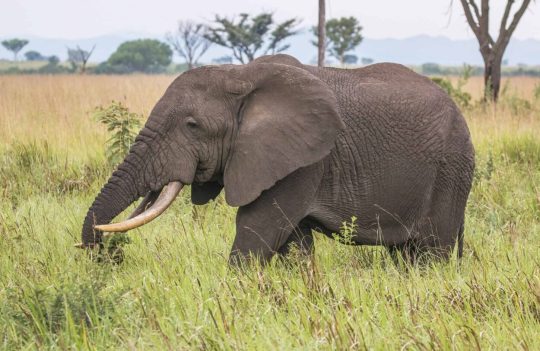
“The WILD Act supports funding two different initiatives: […] the U.S. Fish and Wildlife Service’s Partners for Fish and Wildlife Program offers critical support for voluntary conservation initiatives[, and…] The Multinational Species Conservation Funds play a pivotal role in supporting the conservation of imperiled species globally”
5. Private Gender Affirming Care Ban Fails To Advance In England After "Ferret Filibuster"

“A bill banning puberty blockers for trans youth and defining sex to exclude trans people was blocked from being heard after Labour MPs spoke at length on pet names and ferrets.”
6. Community-Led Effort to Plant Thousands of Seedlings
“Despite its urban surroundings, [the Tucki Tucki] creek serves as a vital refuge for the endangered platypus and purple spotted gudgeon populations. […] Planting native vegetation along the water’s edge serves multiple purposes. Not only does it provide crucial habitat for the endangered species, but it also helps stabilise the banks, mitigating erosion and reducing sedimentation in the creek.”
7. Court Ruling Halts Wolf Trapping and Snaring in Idaho Grizzly Bear Habitat

“[The ruling] will stop trapping and snaring […] to prevent the unlawful take of Endangered Species Act-protected grizzly bears. The decision stated, “There is ample evidence in the record, including from Idaho’s own witnesses, that lawfully set wolf traps and snares are reasonably likely to take grizzly bears in Idaho.””
8. A Boston grocery store is bringing community solar to a low-income area

“A group of energy-equity advocates in Boston is launching a community solar cooperative they say could be a scalable model for both reducing carbon emissions and building wealth in disadvantaged communities.”
9. Two-faced solar panels can generate more power at up to 70% less cost
“Scientists at the University of Surrey have built a new kind of solar panel with two faces, both of them pretty. Their flexible perovskite panels have electrodes made of tiny carbon nanotubes. These can generate more power with greater efficiency and at a cost 70% lower than existing solar panels.”
10. It's a boy! Athens zoo welcomes birth of rare pygmy hippo

“A rare and endangered pygmy hippopotamus has been born in Athens’ Attica Zoological Park for the first time in 10 years, delighting conservationists. A lack of male pygmy hippos in captivity had complicated breeding efforts, so zoo staff were “absolutely thrilled” the baby was a boy”
March 8-14 news here | (all credit for images and written material can be found at the source linked; I don’t claim credit for anything but curating.)
#good news#hopepunk#antelope#animals#extinction#conservation#solar#flowers#us politics#lgbtq#ferret#gender affirming care#native plants#wolf#grizzly bear#boston#poverty#solar power#solar energy#solar panels#zoo#hippo#pygmy hippo#baby animals#nature#wildlife#trans healthcare#deer#yellowstone
12 notes
·
View notes
Text
Art in HotD - 1x05 “We Light The Way”
(more art in Westeros) - (more art in HotD)
(Make sure to click through, these images are BIG)
There’s no doubt about what makes the meaty part of this episode: Corlys’ art collection. But first, a good panoramic look at High Tide:

Hard not think of Mont Saint-Michel. Does this make the Stormlands Fantasy Normandy? Maybe, if maritime pines grew there. On the other hand in this very episode Larys explained to us that “natural habitat” is an elastic concept on Planetos (which honestly? is consistent with the magical seasons). ETA: The actual filming location is indeed St. Michael’s Mount in Cornwall, historically hosting an abbey founded by benedictine monks coming from… Mont Saint-Michel. (Thanks to Ashaya of History of Westeros and @salty-wench for pointing this out to me!)
But it’s the inside that’s the real treat. We saw a glimpse of it in episode 2, when Corlys and Daemon join forces to fight at the Stepstones.

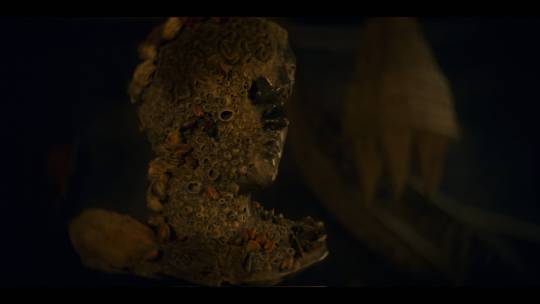
That bronze head covered in coral and sediments makes a clear connection between the Velaryons and the sea they tied their house’s heritage to. Same for what looks like the skull of a deep sea fish on his desk. But they are also bizarre and unique items; let’s put a pin on that.
The great hall in High Tide gives the impression of being spacious and airy, despite being full of items collected by Corlys in his travels. The architecture is very spartan, with some painted decoration on the window arches, that together with the teal walls prevent the room from feeling too austere. I’m also a bit at loss with the diamond texture on the pillar capitals; they don’t really look like any historical style I can think of, though the diamonds have been used in the renaissance for civilian as well as military architecture, just not on capitals.

A good look at the Driftwood Throne; a piece of lore that wasn’t mentioned in the episode was that it was gifted to the Velaryons by the mythical sea deity the Merlin King. It would be interesting to know whether it was the Velaryons who decorated the wood with their heraldic seahorse or if the story goes the other way around - they adopted the seahorse because it was already there? I am leaning towards the former.
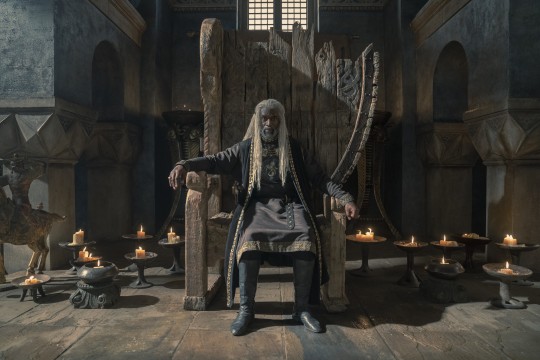
On the bottom left you can also see a mid sized statue of what looks like an Asian warrior, reminiscent of both the terracotta soldiers and of traditional Mongolian iconography. Does this represent an inhabitant of Yi Ti?
Another statement piece besides the throne is the model of the castle on the left side of the room:
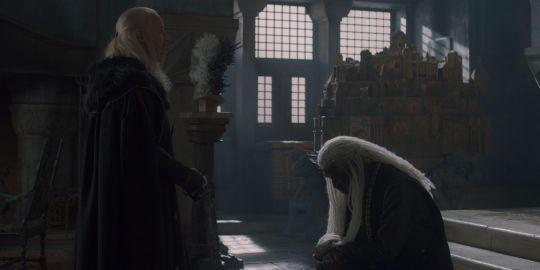
Not gonna lie, during my first viewing I took note of it and I assumed it was a model of High Tide itself, but the actual castle is much smaller. The architecture is also distinctly different from the one in Viserys’ model of Valyria, so it isn’t a representation of the Velaryons’ ancestral land. A possibility is that it is actually Driftmark, so Corlys is watching over both his castles at the same time - and most of all, he is displaying them both. It’s important to note that unlike Viserys’ miniature, this model is meant to be seen by whoever is coming to meet the Lord of the Tides. However, this doesn’t really match the description of Driftmark as dark and cramped, so I’m making a wild guess and saying it is actually a project for the future expansion of High Tide, as the architectural style seems to match, as well as the hilltop silhouette. The model also seems to be made of wood, which was the preferred material for this kind of item back before modern lightweight alternatives and 3D renderings. Note also the statues holding the table, an iconography with its roots in antiquity and that took hold again during the Renaissance before taking a decidedly racist turn shortly after (a huge number of architectural elements but also furniture etc. especially from the 17th and 18th century depict black men in that position, often with exaggerated, grotesque features).
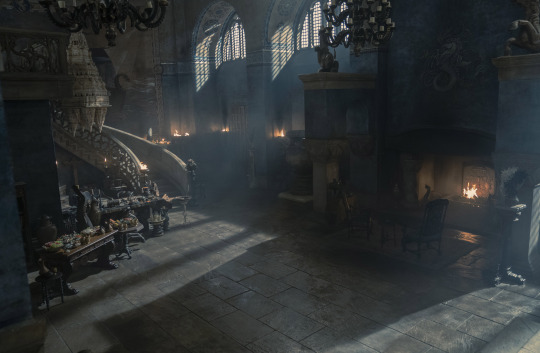
It wouldn't surprise me if the big seashell near the throne was custom made for High Tide especially because of the impeccable color coordination, but I'm not so sure. Something that definitely was commissioned is the huge fresco depicting a ship behind the staircase (why oh why is it behind a staircase??? Corlys you didn't think *this* through). The figurehead represents the titular Sea Snake Corlys' ship gets her name from, preceded by dolphins (both in classical and Medieval/Renaissance iconography a symbol of good fortune for seafarers, and also of speed and intelligence) and it is also going in the direction of the sun, which is interesting in the context of this quote from Fire & Blood:
As for Lady Alys Westhill, born Elissa of House Farman, where her adventure ended we cannot say. The Sun Chaser vanished into the west, still searching for the lands beyond the Sunset Sea, and was never seen again.
Except…
Many years later, Corlys Velaryon, the boy born on Driftmark in 53 AC, would take his ship the Sea Snake on nine great voyages, sailing farther than any man of Westeros had ever sailed before. On the first of those voyages, he sailed beyond the Jade Gates, to Yi Ti and the isle of Leng, and returned with such a wealth of spice and silk and jade that House Velaryon became, for a time, the wealthiest house in all the Seven Kingdoms. On his second voyage, Ser Corlys sailed even farther east, and became the first Westerosi ever to reach Asshai-by-the-Shadow, the bleak black city of the shadowbinders at the edge of the world. There he lost his love and half his crew, if the tales be true…and there as well, in Asshai’s harbor, he glimpsed an old and much weathered ship that he would swear forevermore could only have been Sun Chaser.
Is this fresco both a celebration of Corlys' famous voyages and a declaration of intent - that someday he, or another Velaryon, will go "west of Westeros" the way the legend says Elissa Farman did? Either way, it's as much of a statement piece as the storytelling columns in the Great Hall in King's Landing, except less martial and more aspirational. You can glimpse a bit more of the fresco in some pre release featurette from HBO that I didn’t have the time to track down, which shows the ship is also accompanied by actual sea snakes, and that the painting overlooks what’s basically an altar with the skulls of the Velaryon ancestors wearing oblong helms, clearly representing the ground (well, technically the sea) upon which the house stands.
>
House Velaryon as envisioned by Corlys, however, doesn’t dwell on the past; it is projected towards growth and discovery. There seem to be also some little monochrome scenes in the circles painted into the framing of the bigger fresco, but not even high res production stills are able to show what exactly they are depicting.
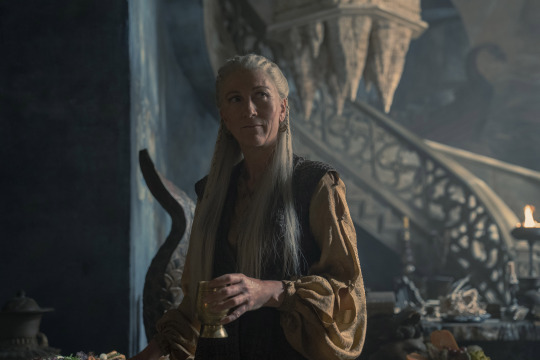
On to items that have been collected rather than commissioned: lots of sea and horse imagery, but no straight up seahorse save for one where the peculiar bend of the tail makes me suspect it had a functional purpose, possibly as an oarlock. There are also items that do not relate directly to the Velaryon heraldry, like that stone element hanging from the ceiling that reminds me of the steeples of Khmer temples like the ones in Angkor, Cambodia. Or what might look like an astronomical tool, relevant for a seafarer, but also interestingly held by serpents, which might indicate more obscure, occult uses (and as the quote above reminds us, Corlys allegedly sailed as far as Asshai). There's a random wooden statue representing a human figure, precious pottery, etc. There's also, notably, the Crabfeeder's mask, which makes me wonder how many of Corlys' treasures were bought or traded and how many are spoils of battle.
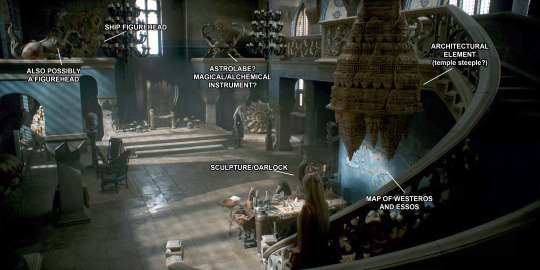
What these items make when grouped together isn't so much a museum or private art collection, as much as a Wunderkammer, or cabinet of wonders. It's important to note that in the eras HotD draws from - basically the late Middle Ages with some tentative leap towards the Renaissance - the notion of art and its value was different than it is now. The way we conceive of art today owes a lot to the Romantic movement and its idea of art as the expression of human emotion - and of individual human genius. Before that, with various degrees of nuance, art was mostly a means to an end, and the artist was generally seen as a glorified craftsman (sometimes craftswoman) whose intellectual and personal contribution began and ended at the formal, technical stage of execution (again: there was wiggle room for this, and increasingly heated debate on figurative artists’ intellectual worth, but I digress). Which is why the Wunderkammer often mixed what we now consider actual, reputable art (or archaeology) with things that were valued just because they were weird and unique, like stuffed exotic animals, weirdly shaped pearls or seashells and whatnot, complex machinery, biological specimens going from the bizarre to the macabre. Cabinets of wonders have often been the starting point for the construction of modern museums, but Westerosi culture is still very far away from conceptualizing museums or private art collections in the modern sense, however they have the right mindset to start building Wunderkammern.

In a way, Corlys is the closest thing Westeros has to a Renaissance prince right now, because he claims ancient nobility but he's also a self made man, whose influence relies on a wealth built on trade rather than on the ownership of land or natural resources. And, like a Renaissance prince, he has a keen understanding of the use of art and decor as a means to communicate what he and his family are, what they were and what they want to be.

I thought High Tide would take over all of this week's post BUT we have at least a couple of tidbits from the Red Keep. We get a nice look at Alicent's quarters, and while the walls are dominated by the usual dragon orgies, I spotted that little aedicule near the window. Unfortunately we can't see what it contains, but my money would be on some little painting or icon relating to the Seven, a little niche for Alicent's devotion amongst the aggressively pagan wall art. It would be in line with the thinly veiled Catholic references the Faith is built upon, as it's pretty common for Catholic devotional paintings or statues (especially of saints or the Virgin Mary) to be housed in aedicules. It's a small thing, but I'm very curious to see whether and where the production design slips Faith iconography in the background, as it seems to be one of the main divides between the Greens and the Blacks.

Also, peep the dolphin shaped table legs, a popular motif during the Renaissance in general but, besides the meanings we've seen in relation to Corlys, also traditionally associated with nobility and faithfulness, hence a fitting iconography for a queen consort.
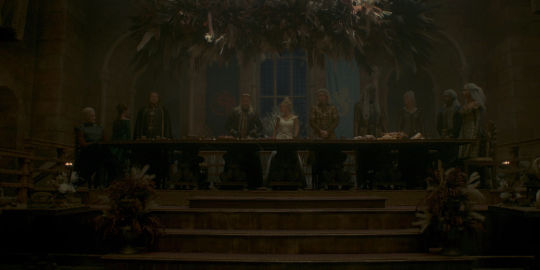
Last but not least, this isn't artwork per se, but it's hard not to see a callback to Last Supper imagery when it comes to the high table at the wedding feast - but rather than Leonardo's famous painting I got reminded of a slightly older iconography which explicitly singled Judas out. Which isn't to say Daemon is literally the Judas in the scenario, especially if we take Rhaenyra as the "Jesus" of the scene - she even has a halo/crown created by the outline of the Iron Throne when she’s seated... - but he is definitely a disruptor. Though not as disruptive as Alicent, the real odd one out here, arriving late and dressed in green as she joins a table that's basically composed of the future Blacks. Ironically, from her point of view it's Rhaenyra who is the Judas in the picture.
(also high res production stills show us some more details about the reliefs on the Great hall columns - yeah that's indeed a Targaryen shield there in the upper right. Now, if only I could make out what's on the shield more to the left...)
#art in hotd#house of the dragon#hotd meta#hotd 1x05#fire and blood#art history#this is so long........ i'm very sorry i even tried cutting stuff out#blame it on famous hoarder corlys velaryon#renaissance#wunderkammer
95 notes
·
View notes